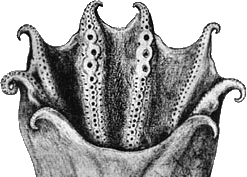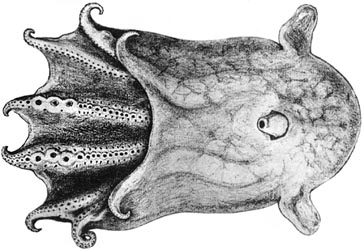Opisthoteuthis albatrossi
Richard E. Young and Michael VecchioneIntroduction
O. albatrossi was originally described from four specimens and placed in the genus Stauroteuthis. The enlarged suckers, however, clearly show that it belongs in the genus Opisthoteuthis. Another similar species of Opisthoteuthis (O. californiana) occurs in Japanese waters but has never been closely compared with O. albatrossi because of the latter's incorrect generic placement.
Characteristics


Figure. Oral view of the dordal arms of Opisthoteuthis albatrossi. Drawing from Sasaki, 1929.
- Arms and web
- Male: Each arm I with 3 greatly enlarged suckers (plus 2 or 3 suckers of intermediate size) in distal field.
- Proximal field absent (Nesis, 1982/87).
- Suckers number "80 or more" on each arm.
- Largest arm suckers (except for distal field of arms I) are suckers 6-7.
- Web along ventral arm margins with "faint nodule-like thickening."
Comments
More details of the description of O. albatrossi can be found here.
O. albatrossi and O. californiana are distinctive among species of Opisthoteuthis in having greatly enlarged suckers in the distal field only on arms I. The holotype of O. albatrossi is a young male and the proximal field may not have developed. These two species could be synonyms (Hochberg, pers. comm.)
Distribution
Type locality: Off Kinkasan, Rikuzen Prov., Japan. Northern Pacific boreal species, known from Sea of Okhotsk, Bering Sea and Southern California (Nesis, 1982/87).
References
Nesis, K. N. 1982/87. Abridged key to the cephalopod mollusks of the world's ocean. 385+ii pp. Light and Food Industry Publishing House, Moscow. (In Russian.). Translated into English by B. S. Levitov, ed. by L. A. Burgess (1987), Cephalopods of the world. T. F. H. Publications, Neptune City, NJ, 351pp
Sasaki, M. 1929. A monograph of the dibranchiate cephalopods of the Japanese and adjacent waters. Journal of the College of Agriculture, Hokkaido Imperial University, 20(Supplementary number):1-357.
About This Page

University of Hawaii, Honolulu, HI, USA

National Museum of Natural History, Washington, D. C. , USA
Page copyright © 2016 and
 Page: Tree of Life
Opisthoteuthis albatrossi .
Authored by
Richard E. Young and Michael Vecchione.
The TEXT of this page is licensed under the
Creative Commons Attribution-NonCommercial License - Version 3.0. Note that images and other media
featured on this page are each governed by their own license, and they may or may not be available
for reuse. Click on an image or a media link to access the media data window, which provides the
relevant licensing information. For the general terms and conditions of ToL material reuse and
redistribution, please see the Tree of Life Copyright
Policies.
Page: Tree of Life
Opisthoteuthis albatrossi .
Authored by
Richard E. Young and Michael Vecchione.
The TEXT of this page is licensed under the
Creative Commons Attribution-NonCommercial License - Version 3.0. Note that images and other media
featured on this page are each governed by their own license, and they may or may not be available
for reuse. Click on an image or a media link to access the media data window, which provides the
relevant licensing information. For the general terms and conditions of ToL material reuse and
redistribution, please see the Tree of Life Copyright
Policies.
- First online 13 May 2003
Citing this page:
Young, Richard E. and Michael Vecchione. 2003. Opisthoteuthis albatrossi . Version 13 May 2003 (under construction). http://tolweb.org/Opisthoteuthis_albatrossi/20152/2003.05.13 in The Tree of Life Web Project, http://tolweb.org/








 Go to quick links
Go to quick search
Go to navigation for this section of the ToL site
Go to detailed links for the ToL site
Go to quick links
Go to quick search
Go to navigation for this section of the ToL site
Go to detailed links for the ToL site